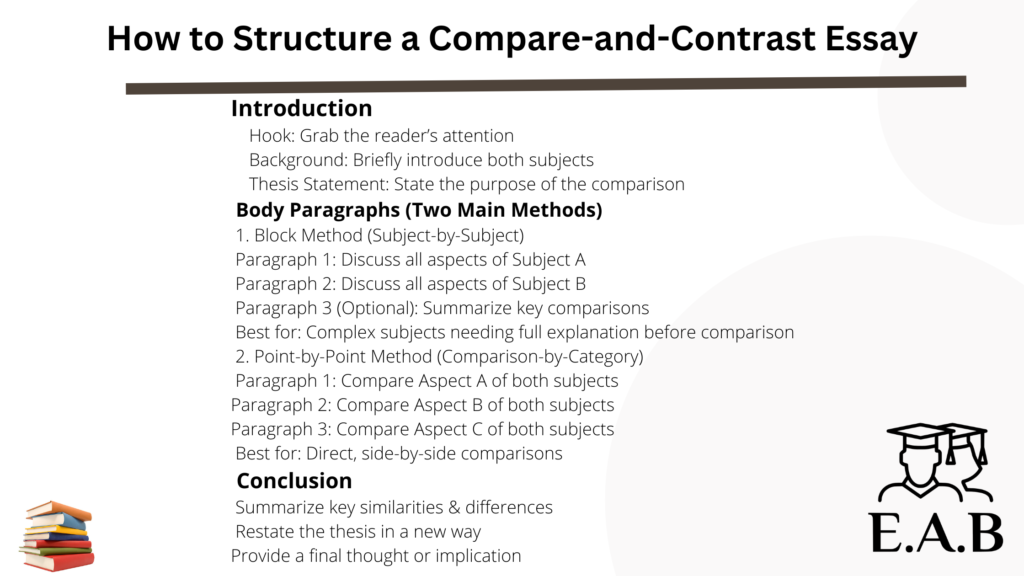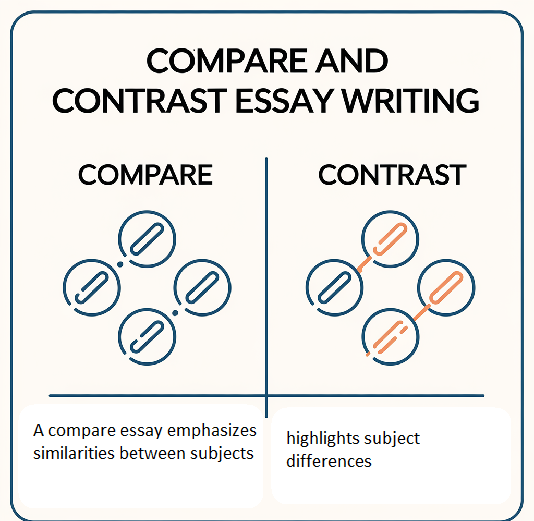Have you ever been stuck between two ideas, weighing their similarities and differences? That’s precisely what a compare and contrast essay is all about.
Whether you’re analyzing two historical events, literary characters, or opposing viewpoints, this essay helps you break down key points to form a clear, structured argument. Many students struggle to go beyond simply listing similarities and differences.
A great compare and contrast essay doesn’t just point things out. It provides meaningful analysis and insight.
What is a Compare and Contrast Essay
A compare and contrast essay is an academic essay that examines the similarities and differences between two or more subjects. This type of paper requires you to analyze the topics critically and objectively and to present your findings in a structured, clear, and concise way.
The compare and contrast essay generally begins with an introduction that provides a brief overview of the subjects being compared and contrasted.
This is followed by the body of the paper, where you present the similarities and differences between the subjects in a logical and organized manner. The body may be structured in different ways, such as by alternating between similarities and differences or discussing one subject in detail.
Purpose of a Compare-and-Contrast Essay
A compare-and-contrast essay helps readers understand the relationship between two or more subjects by examining their similarities and differences. But it’s more than just listing traits, it’s about analyzing, evaluating, and drawing meaningful conclusions based on the comparison.
Here are the key purposes of a compare-and-contrast essay:
- To highlight similarities and differences – It helps break down complex topics, making them easier to understand.
- To develop critical thinking skills – By analyzing two subjects side by side, writers learn to assess information objectively.
- To make informed decisions – Whether choosing between two products, theories, or perspectives, this essay format aids in forming logical conclusions.
- To strengthen argumentative writing – By presenting a well-structured comparison, writers can build strong, persuasive arguments.
Structure of a Compare-and-Contrast Essay
A well-structured compare-and-contrast essay ensures clarity and logical flow, helping readers understand the similarities and differences between two subjects. While there are different ways to organize this type of essay, the block method and the point-by-point method are the most common structures. Regardless of the chosen format, every compare-and-contrast essay consists of three main parts

1. Introduction
The introduction sets the stage for the essay and provides the necessary context. It should include:
- A hook – An engaging opening that grabs the reader’s attention (e.g., a thought-provoking question, an interesting fact, or a brief anecdote).
- Background information – A brief introduction to the two subjects being compared, including their relevance and why they are being examined together.
- A thesis statement – A clear statement that outlines the purpose of the comparison and the main points that will be discussed. This statement should indicate whether the focus is on similarities, differences, or both.
2. Body Paragraphs
The body of a compare-and-contrast essay presents the analysis, typically following one of two structures:
Block Method (Subject-by-Subject Structure)
In this approach, each subject is discussed separately in its section.
- Paragraph 1: Discuss all key aspects of Subject A (e.g., characteristics, features, strengths, weaknesses).
- Paragraph 2: Discuss all key aspects of Subject B, maintaining the same order of points for consistency.
- Paragraph 3 (optional): Highlight key similarities and differences or provide an overall analysis.
Point-by-Point Method (Comparison-by-Category Structure)
In this method, each paragraph compares one specific aspect of both subjects simultaneously.
- Paragraph 1: Compare Theme A of both subjects.
- Paragraph 2: Compare Theme B of both subjects.
- Paragraph 3: Compare Theme C of both subjects.
3. Conclusion
The conclusion wraps up the essay by reinforcing the main insights. It should:
- Summarize key similarities and differences without repeating details from the body.
- Restate the thesis statement in light of the discussion, emphasizing its significance.
- Provide a closing thought, such as the broader implications of the comparison or a recommendation if applicable.

How to write a compare and contrast Essay
Writing a compare and contrast essay involves analyzing the similarities and differences between two or more subjects. Here are the steps you can follow to write a compare and contrast essay,
- Choose your subjects: Select two or more subjects with similarities and differences. These could be anything, such as two books, two movies, two people, two places, etc.
- Create a list of similarities and differences: List all the similarities and differences between your subjects. This will help you organize your paper.
- Develop a thesis statement: Your thesis statement should summarize the main point of your paper. It should explain what you compare and contrast and why it is crucial.
- Organize your paper: Decide on a structure for your paper. You can organize it either by subject (all similarities and differences for subject A, then all similarities and differences for subject B) or by point (all similarities and differences for one point, then move on to the next).
- Write the introduction: Start your paper with an attention-grabbing statement, provide some background information on your subjects, and end with your thesis statement.
- Write the body paragraphs: Each body paragraph should focus on one point of comparison or contrast. Begin each paragraph with a topic sentence that introduces the point and provides a transition from the previous section. Use specific examples and evidence to support your argument.
- Write the conclusion: Summarize the main points of your paper, restate your thesis statement, and provide a final thought or recommendation.
- Revise and edit: Proofread your paper for spelling, grammar, and punctuation errors. Check that your paper flows logically and that you have supported all your arguments with evidence.
Read more on Term Paper
Top 50 Compare and Contrast Essay Topic Ideas
- Traditional Education vs Online Education
- City Life vs Country Life
- High School vs College
- Android vs iOS
- Physical Books vs eBooks
- Public School vs Private School
- Democracy vs Authoritarianism
- Fast Food vs Home-Cooked Meals
- Traditional Sports vs Esports
- Dogs vs Cats
- Socialism vs Capitalism
- American Football vs Soccer
- Classical Music vs Pop Music
- Fiction vs Nonfiction
- Summer vs Winter
- Urbanization vs Industrialization
- Environmentalism vs Consumerism
- European Union vs United Nations
- International Trade vs Domestic Trade
- Renewable Energy vs Fossil Fuels
- Democracy vs. Dictatorship
- American Football vs. Soccer
- Traditional Education vs. Online Education
- High School vs. College
- Public School vs. Private School
- Fiction vs. Nonfiction
- Classical Music vs. Pop Music
- Cats vs. Dogs
- Living in the City vs. Living in the Country
- Environmentalism vs. Consumerism
- Capitalism vs. Socialism
- Global Warming vs. Climate Change
- Renewable Energy vs. Fossil Fuels
- Halloween vs. Christmas
- Marvel vs. DC Comics
- Star Wars vs. Star Trek
- Harry Potter vs. Lord of the Rings
- Marvel Cinematic Universe vs. DC Extended Universe
- iPhone vs. Android
- Mac vs. PC
- Physical Books vs. eBooks
- Fast Food vs. Home-Cooked Meals
- Urbanization vs. Industrialization
- International Trade vs. Domestic Trade
- American Culture vs. European Culture
- American English vs. British English
- Traveling by Car vs. Traveling by Plane
- Apple vs. Samsung
- Nike vs. Adidas
- Classic Literature vs. Modern Literature
Difference between compare and contrast essay
A compare-and-contrast essay analyzes two or more subjects by examining their similarities (comparison) and differences (contrast). However, comparing and contrasting are two distinct processes,
|
Compare |
Contrast |
| Definition |
Identifies similarities between two or more subjects. |
Identifies differences between two or more subjects. |
| Focus |
It shows how subjects are alike. |
Highlights how subjects are different. |
| Purpose |
It helps readers see common traits and connections. |
It helps readers understand unique characteristics. |
| Example Topic |
“Similarities between Online and In-Person Learning” |
“Differences Between Online and In-Person Learning” |
| Essay Approach |
Explains the shared features of both subjects. |
Discusses opposing traits and characteristics. |
| Combined Approach |
Many essays include both comparing and contrasting to provide a complete analysis. |
|
Both elements are typically included in a compare-and-contrast essay to give a well-rounded perspective. However, depending on the objective, some essays may focus more on one than the other.
Compare and contrast essay examples
Example 1: Traditional Learning vs. Online Learning
Introduction
Education has changed significantly, with online learning becoming a popular alternative to traditional classroom education. Both methods aim to provide knowledge and skills but differ in structure, flexibility, and student engagement. This essay compares and contrasts traditional and online learning to highlight their advantages and challenges.
Body Paragraphs
1. Structure and Accessibility
Traditional learning follows a fixed schedule, requiring students to attend physical classrooms, which ensures discipline and routine. However, this can be inconvenient for students with busy schedules. In contrast, online learning provides greater accessibility, allowing students to attend classes from anywhere and making education more inclusive for those with mobility challenges or full-time jobs.
2. Flexibility and Time Management
Online learning offers flexibility, enabling students to learn at their own pace. This is particularly beneficial for self-motivated learners. On the other hand, traditional learning follows a rigid schedule, which may be challenging for students to balance education with different responsibilities but helps maintain a structured learning process.
3. Interaction and Engagement
In traditional classrooms, students interact face-to-face with teachers and peers, fostering better communication and collaborative learning. However, online learning relies on virtual interactions through forums and video calls, which can sometimes feel impersonal, though it provides convenience and the ability to review recorded lectures.
Conclusion
Both traditional and online learning have their pros and cons. Traditional education offers structure and in-person engagement, while online learning provides flexibility and accessibility. The two choices depend on a student’s learning style, lifestyle, and educational needs.
Example 2: Public Transport vs. Private Transport
Introduction
Choosing between public transport and private transport is a common dilemma for commuters. Both options serve the purpose of transportation but differ in cost, convenience, and environmental impact. This essay explores these differences to determine which mode of transport is more beneficial based on different circumstances.
Body Paragraphs
1. Cost
Public transport is generally more affordable, with lower ticket prices compared to the costs of owning and maintaining a private vehicle. Gasoline, insurance, and maintenance expenses make private transport more expensive, though it provides greater control over travel schedules.
2. Convenience and Flexibility
Private transport offers the convenience of direct routes and personalized schedules, eliminating waiting times and crowded conditions. Public transport, however, follows fixed routes and schedules, which can sometimes be unreliable. However, it reduces the stress of driving, parking, and fuel expenses.
3. Environmental Impact
Public transport is more environmentally friendly, as buses and trains reduce the number of individual vehicles on the road, lowering carbon emissions. Private cars, especially those using fossil fuels, contribute significantly to pollution and traffic congestion. However, electric and hybrid vehicles are helping reduce the environmental impact of private transport.
Conclusion
Both public and private transport have their benefits and drawbacks. While public transport is cost-effective and eco-friendly, private transport offers flexibility and convenience. The choice depends on budget, travel needs, and environmental concerns.
Read also on How to write an evaluation essay









 Evan John
Evan John
